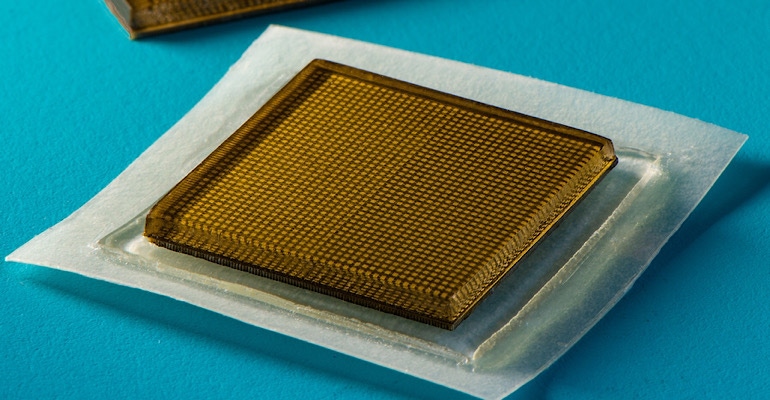Are These Miniature Ultrasound Patches the Next Big Thing?
MIT and University of California-San Diego researchers have developed prototypes of ultrasound probes about the size of a postage stamp.
March 28, 2023

Researchers at the Massachusetts Institute of Technology and the University of California-San Diego have developed two prototypes of what could be the “next big thing” in ultrasound technology – “next big thing” being complete ultrasound probes about the size of a postage stamp.
For Xuanhe Zhao, professor of mechanical engineering and director of the Zhao Lab at MIT, his work is a logical continuation of decades of researchers making ultrasound technology not only more convenient for both providers and patients but also far more capable than even the best equipment is today.
“I have two big dreams,” Zhao said. “I want to make ultrasound imaging viable for global health, which means making it cheaper and more accessible to many people – similar to the Apple Watch or Fitbit. And in terms of biological research, we can currently have super resolution of single cells, but a human body has trillions of them. Currently, we don’t have a technology that can image the whole body. Eventually, we want to develop such a capability, and ultrasound is probably the only imaging modality that can do that.”
Zhao said his lab’s device, published in Science, might also expand clinical ultrasound’s efficacy not just in terms of the area it can cover, but also for the duration. In both hospital ultrasound suites and point-of-care uses, a sonography session is limited to the amount of time a provider can hold a probe in place and the ability of the conducting hydrogel to remain viable. Zhao’s multi-layered patch can stay in place for up to 48 hours.
“We need long-term continuous imaging,” Zhao said. “A point-of-care ultrasound isn’t able to do that. You can’t hold it there for 48 hours. For some heart disease conditions, symptoms can be very sporadic. You might feel chest pain for two minutes, and you need a test for that in the moment. The key idea is that many diseases – heart disease, hypertension, certain types of intestinal diseases – require continuous imaging.”
The UCSD team also reported their device, published in Nature, worked for long durations, according to a USCD news story, which said the device can be worn for up to 24 hours.
Different approaches
What may be most intriguing about the two projects is that, though both devices are explained as being the size of a postage stamp, they take different approaches to achieving adequate results. The MIT device is a combination of a small rigid transducer array embedded in a three-layer combination – two layers of elastomer bioadhesive that sandwich a layer of hydrogel. The entire device is just 3 to 5 millimeters thick.
The UCSD device, on the other hand, is fully flexible, and the research team used a combination of approaches to ensure image quality: they settled on a wide-beam compounding approach in their transmit beamforming strategy, which they said in their paper “achieves a synthetic focusing effect and, therefore, a high acoustic intensity across the entire insonation area, which leads to the best signal-to-noise ratio and spatial resolutions.”
They also compensated for the vagaries of the contours of the human body. Using the example of chest curvature for echocardiography, they said “Uniquely for soft devices, the contours of the human chest cause a non-planar distribution of the transducer elements, which leads to phase distortion and therefore image artifacts. We used a three-dimensional scanner to collect the chest curvature to compensate for element position shifts within the wearable imager and thus correct phase distortion during transmit and receive beamforming.”
They compared the performance of the wearable device with a commercial device in four primary views of echocardiography, and concluded the difference between the results from the wearable and commercial devices was “negligible.” The study’s senior author, Sheng Xu, had no further comment about the work.
What’s next
Both teams reported that their next steps would be to create wireless capabilities for their devices – the reported prototypes were hardwired to monitoring equipment. Zhao said his team has already perfected that, as well as adding artificial intelligence to its interpreting algorithm to better analyze images. Ultimately, Zhao envisions ultrasound stickers could be packaged and purchased by patients and consumers, and used not only to monitor various internal organs, but also the progression of tumors, as well as the development of fetuses in the womb.
The UCSD team plans to commercialize its technology through Softsonics, a UCSD spinoff founded by Xu and colleague Shu Xiang, according to a university news story. Zhao said he also plans to launch a startup but is waiting for his team’s technology to mature.
About the Author(s)
You May Also Like

.png?width=300&auto=webp&quality=80&disable=upscale)
